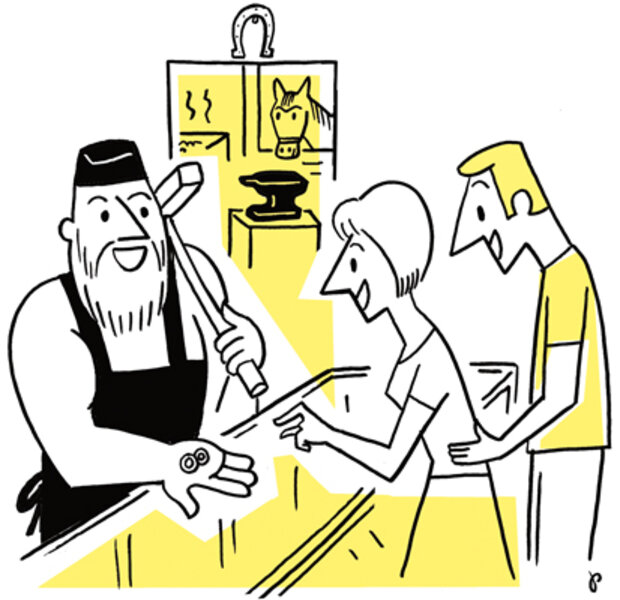Record gold prices spur wedding ring alternatives
Loading...
| Milwaukee
Army Spc. Marco Negron of Highland Park, Ill., wears a wedding band made of tungsten so that – unlike the gold ring from his previous marriage – it won't get banged up no matter how rugged his duties.
Elizabeth Dobbs, a biologist in Madison, Wis., and her fiancé are shopping for a ring set with laboratory-made simulated diamonds so she can enjoy her sparkler without wondering if human rights were compromised in the production of her ring.
Wedding jewelry has acquired a decidedly post-recession luster. With incomes low and precious metal prices stratospheric – gold prices closed at a record $1,509 an ounce on Monday – some couples can no longer afford to go the traditional route. And it's no longer a given that couples exchange inexpensive rings and then save up for real gold and diamonds. Instead, today's trend is toward individual expression, along with a backlash against mining practices seen as exploiting human labor and the earth.
The result? Growing demand for rings made with alternative substances.
For men, there's an explosion of choices, with rings made of titanium, tungsten carbide, cobalt, and steel. Black wedding rings are popular, as are varying shades of silver and gray, often within the same ring. Some rings are inlaid with 14-karat yellow, red, or white gold. Specially fused metals give a zebra-striped or mokume gane (Japanese for "wood-grained") effect.
Unlike their fathers' plain narrow bands, many grooms are choosing wide rings with bold designs. They're not only more visible, they're stronger.
"Once, I scraped it hard along the cement when they said, 'Drop down and give me push-ups,'" says Mr. Negron of his three-year-old tungsten ring. To his relief, it showed no damage.
Women are open to alternatives, too. "It's important to me to feel socially responsible," says Ms. Dobbs, trying on rings at a Diamond Nexus Labs store in a Milwaukee-area mall. "I don't think you can ever know for sure the history of a diamond and how it was mined."
Manufactured stones and "contemporary" metals can also slash costs. Ron Ruback, a jeweler in Kansas City, Mo., says a man's gold band can top $1,000 these days. That compares with $50 to $300 for a titanium, steel, or tungsten ring.
"With platinum at $2,000 an ounce and gold at $1,400 an ounce, you have a lot of imagination going into alternatives," says Russell Shor, senior industry analyst with the nonprofit California-based Gemological Institute of America (GIA).
Gold might be losing its shine for other reasons, too. Men associate industrial-type metals with strength and space-age technology, says Ron Yates, a Modesto, Calif., jeweler. "High-end golf clubs and racing bicycles are made with titanium." Because alternative rings are highly scratch-resistant compared with gold, they've gained a following among blue-collar and military men.
Intense competition has sparked heated disagreements and legal battles. Four years ago, for example, Gregory Ballash started selling tungsten rings from his Salt Lake City-area base. But tungsten has come under fire from jewelry designer Scott Kay, who has held press conferences and posted videos on YouTube showing the rings shattering upon being dropped or tapped. "Brittle is not for bridal," says Kay's spokesman Dan Scott.
Jewelers and makers of tungsten rings have been successfully sued for patent infringement by California businessman Trent West, who designed rings under the name TrewTungsten. Diamond Nexus Labs has threatened lawsuits against Texas gemologist Robert James and a jewelers' online forum for posting test results that concluded Diamond Nexus is ordinary cubic zirconia or CZ. Diamond Nexus says its stones are a combination of 10 elements, including zirconium.
Before making the jump into alternative wedding jewelry, customers should be aware of what they're buying, says Mr. Shor of the GIA. The Federal Trade Commission prohibits anything except crystallized carbon to be advertised as diamond. True synthetic carbon diamonds, created in a lab, are rare. Most simulated diamonds on the market use other elements, such as CZ or moissanite. But labeling regulations are unclear, Shor says, in regard to newer simulants, such as the Asha brand, which bonds carbon diamond crystals to a CZ core. Also important: Tungsten, steel, titanium and cobalt rings cannot be resized and must be replaced in case of weight gain or loss. But the original manufacturer might not be around forever. For example, jewelers say Mr. West has disappeared, leaving them no way to repair or replace his patented TrewTungsten rings.
Women's diamond rings made of sterling silver mixed with platinum is soft and can bend, increasing the risk of lost stones, jewelers say. Electroplated coatings of gold or platinum eventually wear off, but possibly can be restored.
And as comparatively inexpensive, markups on alternative bridal jewelry can be as high or higher than traditional jewelry, it pays to compare prices.





